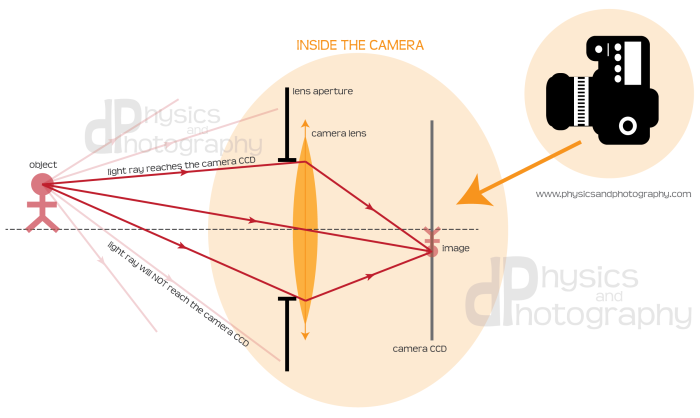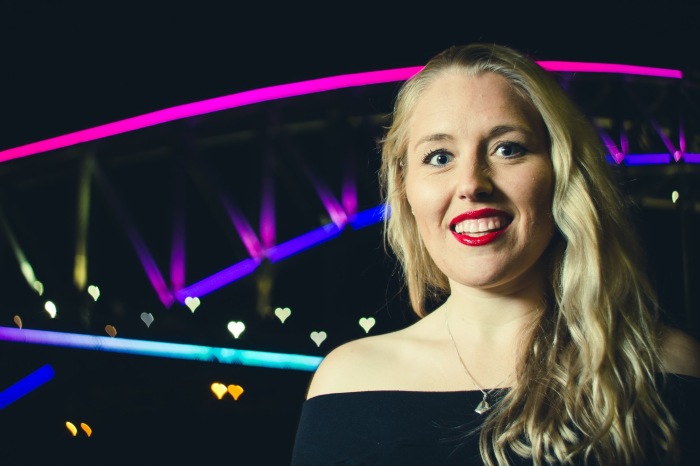I have the secret to getting cool funky shaped bokeh in your images. But if I tell you it won’t be a secret anymore… Oh dear! We’ll just have to keep it between you and me then hehe. Click through to read more about bokeh and the physics behind it.
The word “bokeh” comes from Japanese can be defined as “the way the lens renders out-of-focus points of light“. Today I want to tell you a bit about the physics of bokeh formation and what cool effects it can produce in your photos. To start, let’s look at the inside of a camera. The components we are interested in today are the lens, its aperture, and the CCD. In the diagram below I have illustrated the formation of an image from an object on the camera CCD. As you can see, not all the light rays that originate from the object reach the CCD, only those that go through the lens aperture.

However, if instead of focusing our lens on the object we focus it somewhere else, whether closer or further away, then the image on our CCD will be blurry (positions 1, 2 and 4 in the diagram below). This is due to the fact that the light rays coming from the object that reach the CCD get together all at one point only on the imaging plane (position 3 below). At any other plane after the lens these light rays do not all coincide in the same point, but rather spread out over a finite area (positions 1, 2 and 4 below).

If our background is made of bright lights, when focusing our camera elsewhere these lights will turn into larger circles, which are called bokeh. Everything out of focus will now be made of many circles together but this effect is more noticeable with bright lights because of the contrast with the darker areas of the image.

Bokeh can be very aesthetically pleasing in portrait photography because it helps to separate the subject from the background. Since our subject and background are at different distances from the camera, they will focus a different planes after the lens (see diagram below). This will make one of them be out of focus in our photo (preferably the background hehe).



The lens aperture is the key factor in the bokeh formation process. Both its shape and size play a crucial role in the quality of the bokeh in your image. It is very important to have a large aperture (small f/stop) (I usually use my 50mm f/1.8 when I’m playing with bokeh). This is because a large aperture means a shallow depth of field (more about the physics of this relationship in a future blog post) which makes out of focus things even more out of focus, accentuating the bokeh.
And finally, the best part….. Drumroll….. The shape of the aperture determines the shape of the bokeh! :) If your aperture is circular (like most camera lenses are) then your bokeh will be circular. Essentially, the light that comes from the object and through the aperture forms a cone after the lens, ending on the imaging plane. But if we put our camera’s CCD at any other plane (out of focus) we are obtaining a section of the cone, i.e a circle. This is what I have attempted to illustrate in the following diagram, although I am not sure how clear it is because my perspective illustration skills are not that great hehe.

Similarly, if our lens aperture is of a different shape (a star, for example) then any out of focus light sources will turn into stars!! How cool is that!!!!!! :) :) It is also very inexpensive to make apertures with different shapes. All you need to do is cut out your desired shape on a black cardboard and then place this on the front of your lens (here is a tutorial). Alternatively, if you are lazy like me, you can buy the shapes on eBay hehe.

Here are some of my favourite bokehliciousness images that I have taken with different shaped apertures. My favourite is the love heart bokeh!



I really want to combine portraiture with funky shaped bokeh but I’m finding it harder than anticipated and I’m still working on it. Here is my best attempt so far:

A good combination I really reccommend is a glass orb and funky bokeh. Check out my previous post on this blog about the physics and photography of glass orbs. Glass orbs create an image of the background closer to the camera so when focusing on this image the background is very out of focus, making it an ideal candidate for bokeh :)

This is all from me for today. If you have enjoyed this post I reccomemnd you check out the video below for more cool bokeh shapes and ideas :)
Thank you for reading!
xx Ana :)
Ps. Check out the post on “Computational Bokeh” to see how we can achieve this effect in post :)

Cool article well explained
LikeLike
Thanks so much Paul :)
LikeLike
Very cool Ana, Can’t wait to try this technique. Thanks for sharing this.
LikeLike
Thanks Carl :) I look forward to seeing your result!
LikeLike
[…] with different shapes my first thoughts were “this is the convolution product!!”. In my previous post on this blog I showed you how to achieve this effect in camera, with different shaped apertures. […]
LikeLike
[…] In conclusion, the depth of field of a photograph depends on several factors, which we can use to our advantage when out shooting. It also plays a major role in the creation of images with nice bokeh (check out my “Bokehliciousness” blog post). […]
LikeLike
I am starting to read your blog in detail, I came for the orbs and stayed for all the of the other wonderful posts.
Thank you so for putting your time and expertise into this. I have been an amature photographer my entire life and I am learning so much, and that is making me a better photographer.
Plus that orb shot in this post is terrific.
LikeLike
Thanks so much Gary :) it makes me very happy to hear you are enjoying my posts!!
LikeLike
Bokehliciousness | Physics & Photography isn’t a
best article, but it covers many knowledge.
LikeLike
[…] personal favourites of mine have been my “Orbaliciousness” and “Bokehliciousness” posts, as the physics behind them is simple and elegant, producing marvellous results! These two […]
LikeLike